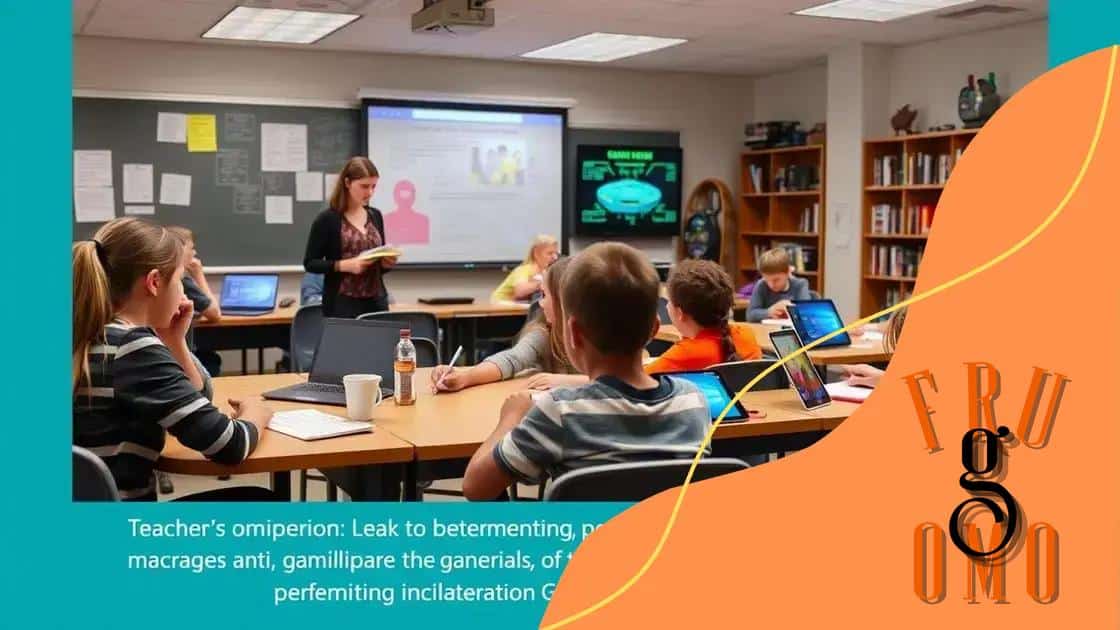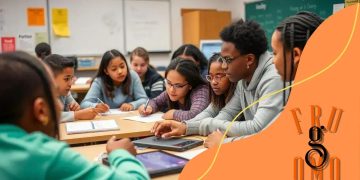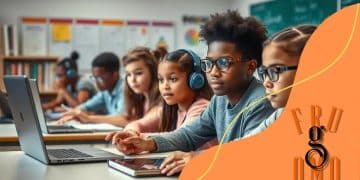Gamification in online learning: engaging students effectively

Gamification in online learning enhances student engagement, motivation, and retention by integrating game design elements and technologies like AI and VR into educational experiences.
Gamification in online learning offers a fresh approach to traditional education. By incorporating game elements, educators can enhance student participation and motivation, making the learning experience more enjoyable. So, how does this play out in the digital classroom?
Understanding gamification in education
Understanding gamification in education is crucial for modern teaching methods. This approach uses game design elements to enhance learning experiences. By transforming traditional lessons into interactive challenges, educators can capture students’ attention and make learning more enjoyable.
What is Gamification?
Gamification involves incorporating game-like features, such as points, badges, and leaderboards, into the learning process. These elements motivate students to engage more deeply in their studies. Instead of viewing assignments as chores, they see them as opportunities to earn rewards.
Key Benefits of Gamification
- Increased Engagement: Students are more likely to participate when learning feels like a game.
- Enhanced Retention: Interactive elements help to solidify knowledge and improve memory.
- Motivational Elements: Rewards encourage students to strive for achievement.
With the integration of gamification, classrooms become vibrant spaces filled with excitement. When students are motivated by the potential to earn rewards, they are more likely to take risks, explore new ideas, and develop a positive attitude toward learning. Challenges and quizzes can turn into friendly competitions that foster collaboration and communication among peers.
Moreover, many game mechanics, such as storytelling and character development, can be applied in educational settings. These techniques captivate students’ imaginations and make the subject matter more relatable. As learners progress through levels, they experience a sense of accomplishment that boosts their confidence.
Examples of Gamification in Education
There are numerous ways to implement gamification in academia. Some popular examples include educational apps that use games to teach math and language skills. Similarly, online platforms may track student progress and display achievements. This not only keeps students accountable but also encourages healthy competition.
- Educational Games: Tools like Kahoot! and Quizizz allow teachers to create fun quizzes that engage students.
- Classroom Competitions: Setting up challenges among students can yield exciting results and foster team spirit.
- Feedback Loops: Using instant feedback not only helps students improve but also keeps them engaged in real-time.
Incorporating gamification in education is not just about adding a few fun elements; it’s about transforming the learning experience. By designing lessons that tap into students’ innate desire for achievement and connection, educators can create dynamic and effective learning environments.
Benefits of gamification in online learning
The benefits of gamification in online learning are significant and can transform how students engage with educational material. By integrating game elements, learners find motivation and excitement in their studies. This approach not only enhances learning experiences but also increases retention of information.
Enhancing Engagement
One of the primary benefits of gamification is that it boosts student engagement. When learning is fun, students are more likely to participate actively in their lessons. They experience a sense of accomplishment when they complete challenges, which motivates them to continue.
Improving Knowledge Retention
Gamification has also shown to improve knowledge retention. Game elements, such as rewards and levels, create an immersive environment. Students are more likely to remember the material when it’s presented in an exciting way. This increased retention is critical for success in both academic and professional settings.
- Immediate Feedback: Gamified systems often provide instant feedback, helping students understand their mistakes quickly.
- Positive Reinforcement: Rewards such as points and badges encourage persistence and reinforce good study habits.
- Motivation to Learn: The competitive aspect can inspire students to strive for improvement and mastery of subjects.
Moreover, gamification fosters a better learning community among peers. By working together to achieve goals, students develop social skills and teamwork. Collaboration is essential in today’s world, and gamified learning environments help cultivate these skills naturally.
Furthermore, gamification in online learning accommodates different learning styles. Visual learners benefit from interactive graphics, while auditory learners can engage with sound effects. This flexibility allows all students to thrive, regardless of their preferred way of learning.
Encouraging Lifelong Learning
The structured challenges and opportunities for progress motivate students to become lifelong learners. As they associate learning with fun experiences, they are more likely to pursue knowledge outside the classroom setting. This endless curiosity is a valuable trait for personal and professional growth.
In conclusion, the advantages of gamification in online learning are clear. By enhancing engagement, improving retention, and creating a positive learning environment, educators can effectively harness the power of gamification to enrich education.
Best practices for implementing gamification

Implementing gamification effectively requires careful planning and execution. By following best practices, educators can create engaging experiences that enhance learning. This approach not only motivates students but also helps them grasp complex concepts in a fun way.
Define Clear Objectives
Before introducing gamification, it’s essential to define clear learning objectives. What do you want students to achieve? Setting measurable goals will guide the design of gamified elements. This ensures that all activities align with the desired outcomes, making the experience purposeful.
Know Your Audience
Understanding your students is crucial. Different age groups and learning styles respond to various game elements. For example, younger students may enjoy colorful graphics and playful challenges, while older students might appreciate more sophisticated game mechanics. Tailoring the approach based on audience preferences leads to better engagement.
- Surveys: Conduct surveys to gather insights about student interests.
- Observation: Pay attention to how your students interact with different learning formats.
- Feedback: Regularly seek feedback on what elements they enjoy most.
Integrating game elements should enhance the learning process, not distract from it. Thus, it’s vital to strike a balance between fun and educational value. Ensure that tasks feel rewarding without being overwhelming, allowing students to progress confidently.
Incorporate Variety
Diverse activities keep students interested. Consider using a mix of quizzes, challenges, and cooperative tasks. Changing the type of gamification elements also helps maintain excitement. For instance, introduce leaderboards to foster friendly competition one week and collaborative projects the next.
- Quizzes: Use interactive quizzes to assess knowledge.
- Challenges: Create unique challenges that encourage critical thinking.
- Group Projects: Foster teamwork with collaborative tasks.
Using technology can enhance the gamified experience. Platforms that support digital badges, points, and progress tracking offer tools that are effective and engaging. Gamified learning management systems can streamline the process and make it easier to monitor student progress.
Additionally, ensure there is a feedback loop in place. Providing immediate feedback is crucial in gamified environments. This allows students to understand their mistakes and learn from them quickly. Incorporating reward systems, like points or badges, can significantly motivate students to engage more with the material.
Evaluate and Adjust
Once implemented, regularly evaluate the effectiveness of your gamification strategy. Gather data on student performance and engagement levels to determine what works. Be open to making adjustments based on this feedback to improve the learning experience continuously.
By following these best practices, educators can successfully implement gamification in their lessons, leading to improved outcomes. Engaging students not only makes learning enjoyable but also encourages them to take ownership of their education.
Challenges in gamifying online courses
While gamifying online courses presents many advantages, there are also notable challenges that educators must navigate. Understanding these obstacles can help in designing better learning experiences that maximize the benefits of gamification.
Technical Barriers
One major challenge is the technical barrier. Not all students may have access to the necessary technology to participate fully in a gamified course. This can create disparities in the learning experience, where some students benefit more than others. Ensuring that all students have the required devices and internet access is essential for successful implementation.
Resistance to Change
Another significant hurdle is resistance to change. Some educators and students are accustomed to traditional teaching methods and may be hesitant to adopt gamified approaches. This can be compounded by a lack of familiarity with gaming concepts or skepticism about their effectiveness in learning.
- Educators: Some teachers may doubt the effectiveness of gamification compared to traditional methods.
- Students: Students might feel overwhelmed by new game-based systems.
- Training: Lack of proper training for educators can hinder effective gamification.
Balancing fun with educational rigor is also a challenge. While gamification aims to make learning engaging, it’s crucial to ensure that educational standards are not compromised. Game elements must align with learning objectives and support the curriculum effectively.
Maintaining Engagement
Keeping students engaged over time can be difficult. Initially, the novelty of gamification may capture attention, but sustaining this interest requires constant innovation. Educators must continually evolve the gamified elements to prevent boredom and maintain motivation.
- Frequent Updates: Regularly updating content and challenges helps keep the experience fresh.
- User Feedback: Gathering feedback can provide insights on what works and what doesn’t.
- Variety: Introducing different types of game mechanics can help sustain interest.
Finally, measuring the effectiveness of gamification can be complex. Quantifying student engagement and learning outcomes in a gamified environment is not always straightforward. Educators need to establish metrics that accurately reflect the impact of gamified strategies on student learning.
Overcoming these challenges requires thoughtful planning and flexibility. By being aware of these pitfalls and actively working to address them, educators can enhance the effectiveness of gamification in online courses, ultimately leading to better learning experiences for all students.
Future trends in gamification and learning
The future trends in gamification and learning are evolving rapidly as technology advances and education adapts to new demands. As more educators embrace gamified approaches, several exciting developments are emerging that promise to reshape the learning landscape.
Integration of Artificial Intelligence
One significant trend is the integration of artificial intelligence (AI) into gamified learning platforms. AI can create personalized learning experiences by analyzing student data and adapting challenges to meet individual needs. This means that students receive tailored tasks that match their skills and learning pace, enhancing both engagement and effectiveness.
Increased Use of Virtual and Augmented Reality
Virtual Reality (VR) and Augmented Reality (AR) are also making waves in gamified education. These technologies allow for immersive experiences where students can interact with the material in a three-dimensional environment. Imagine exploring historical sites or conducting science experiments in a virtual lab, making learning more engaging and memorable.
- Immersive Learning: VR and AR can transport students to different places and times, aiding understanding through experience.
- Interactive Scenarios: These tools enable students to practice skills in realistic environments.
- Enhanced Motivation: The novelty of VR and AR keeps students excited about learning.
Furthermore, mobile learning is rapidly expanding. With the availability of educational apps, students can access gamified content anytime, anywhere. This flexibility supports lifelong learning by allowing users to engage with learning materials on their devices, whether they are at home or on the go.
Focus on Collaborative Gamification
The trend toward collaboration in gamified learning is also gaining momentum. Group challenges and cooperative games promote teamwork and communication skills. These activities encourage students to work together to solve problems, fostering a sense of community and shared purpose. Teachers may increasingly design courses that require collaboration, reflecting real-world work environments.
- Peer Interaction: Group settings help build social skills and enhance learning.
- Shared Goals: Working together on challenges strengthens motivation.
- Creating Leadership Skills: Collaborative gamification can help students demonstrate and develop leadership abilities.
Lastly, the focus on data analytics to track student progress in gamification will become more prevalent. By analyzing data, educators can gain insights into student engagement levels and learning outcomes. This information can be used to refine educational strategies, ensuring that gamification remains effective and aligned with learning goals.
In summary, the future of gamification and learning holds great promise. With advancements in technology and an emphasis on personalized, collaborative learning experiences, education can become more engaging and effective than ever before.
In conclusion, the integration of gamification in online learning is reshaping education. As technology advances, students experience more engaging and interactive lessons. From AI and VR to collaborative activities, the future of learning is bright. These trends promise to enhance motivation and support diverse learning styles, making education more accessible and enjoyable for everyone. By embracing these changes, educators can create rich learning experiences that prepare students for success.
FAQ – Frequently Asked Questions about Gamification in Online Learning
What is gamification in education?
Gamification in education involves using game design elements in learning to boost engagement and motivation among students.
How can AI enhance gamified learning?
AI can personalize learning experiences by adapting challenges based on individual student performance and needs.
What are the benefits of using virtual reality in gamified courses?
Virtual reality creates immersive learning experiences, making lessons more engaging and helping students understand complex concepts.
How can collaboration be incorporated into gamified learning?
Collaboration can be fostered through group challenges that encourage teamwork and communication, reflecting real-world scenarios.





